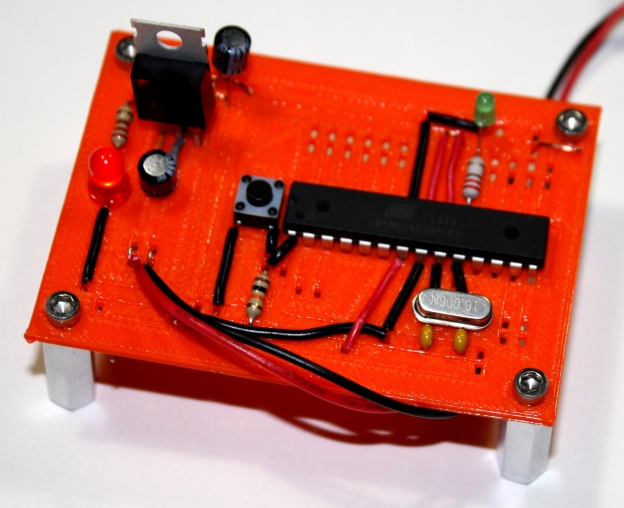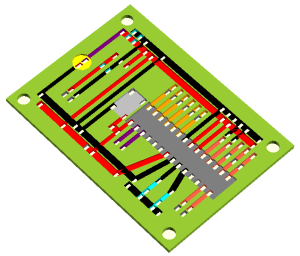The SCADuino Primo – a proof-of-concept SCADBoard
By: J. Pagliaccio and B. Reidy March 2014
3D Printed Breadboard Arduino
SCADuino is a 3D printable version of the Breadboard Arduino at Arduino.cc. Using OpenSCAD and the SCADBoard library it is easy to create a 3D printable breadboard like the Breadboard Arduino.
The design for the Breadboard Arduino can be found at the Arduino website here: http://arduino.cc/en/Main/Standalone The Arduino site has a step-by-step instruction for assembling the boards plus a bill of materials – the necessary components. All of the components are easy to find on https://www.sparkfun.com/ and https://www.adafruit.com/. We built the Breadboard Arduino first and used it as a reference to build our SCADuino. We also recommend using an Arduino Uno R3 like this https://www.adafruit.com/products/50 for programming the SCADuino. We program and then pop out the Atmega328 and put it in the SCADuino.
The SCADuino Code
We developed two versions of the SCADuino; one with normal size thru holes and one with oversized thru-holes that will fit 2 wires in each hole. Both versions are included in the SCAD file. The code is straight forward with comments in the code. The pictures represent the 2-wire version. Please note the SCADBoard library is at http://scadboard.wordpress.com/.
/*
SCADBoard Library & SCADuino
-------------------------------------------
3D Printable Breadboard Library in OpenSCAD.
File: SCADuino_0_0_13.scad
Copyright (c) 2014, J. Pagliaccio, B. Reidy. All rights reserved.
Redistribution and use in source and binary forms, with or without
modification, are permitted provided that the following conditions are met:
* Redistributions of source code must retain the above copyright notice,
this list of conditions and the following disclaimer.
THIS SOFTWARE IS PROVIDED BY THE COPYRIGHT HOLDERS AND CONTRIBUTORS
"AS IS" AND ANY EXPRESS OR IMPLIED WARRANTIES, INCLUDING, BUT NOT
LIMITED TO, THE IMPLIED WARRANTIES OF MERCHANTABILITY AND FITNESS FOR
A PARTICULAR PURPOSE ARE DISCLAIMED. IN NO EVENT SHALL THE COPYRIGHT
OWNER OR CONTRIBUTORS BE LIABLE FOR ANY DIRECT, INDIRECT, INCIDENTAL,
SPECIAL, EXEMPLARY, OR CONSEQUENTIAL DAMAGES (INCLUDING, BUT NOT LIMITED
TO, PROCUREMENT OF SUBSTITUTE GOODS OR SERVICES; LOSS OF USE, DATA, OR
PROFITS; OR BUSINESS INTERRUPTION) HOWEVER CAUSED AND ON ANY THEORY OF
LIABILITY, WHETHER IN CONTRACT, STRICT LIABILITY, OR TORT (INCLUDING
NEGLIGENCE OR OTHERWISE) ARISING IN ANY WAY OUT OF THE USE OF THIS
SOFTWARE, EVEN IF ADVISED OF THE POSSIBILITY OF SUCH DAMAGE.
By: J. Pagliaccio, B. Reidy
Version History
-------------------------------
v0.0.1 First printed prototype.
v0.0.2 Wider center line fix.
v0.0.3 Added ic module.
v0.0.4 Underwire.
v0.0.5 LED Module.
v0.0.6 Better base and cleanup.
v0.0.7 Parameters for all values.
v0.0.9 Separate x and y values for each hole for 2-wires-in-a-hole.
v0.0.10 SCADuino with 2-wire.
v0.0.11 SCADuino with 2-wire April 2014.
v0.0.12 SCADuino with 2-wire cleanup 1/2 deep May 2014.
v0.0.13 Added license and library file.
*/
// Start of required variables
drillHoleRad = 2;
holeDiam = 1.25; // the tru-hole diameter in mm
holeLenX = holeDiam;
holeLenY = holeDiam;
// if two Wires in One Hole
holeLenY = holeDiam + .9;
holeSpace=2.54; // The hole spacing in mm
//Note: .1 inch = .0254 centimeters
// Thickness of the board
materialThick = 1.5; //2.54; // for prod - measured in mm
// Depth of the troughs
inset = materialThick *.5;
deepInset = materialThick *.5;
// End of required variables
include <SCADBoard_Lib_0_0_13.scad>
/*
Specify breadboards locations using standard breadboard
nomenclature of rows and columns, as follows:
• Specify rows as numbers 1,2,3..
• Specify columns with lower case letters like a standard breadboard a, b, c …
• Valid columns are blp, bln, a, b, c, d, e, 8, 9, f, g, h, i, j, brp, brn.
• blp, bln stand for bus left negative, bus left positive
• brp, brn stand for bus right positive, bus right negative.
• Columns 8 and 9 are valid columns.
*/
// Call the module
// SCADuino1Wire();
SCADuino2Wire();
//----------------------------------------------------------------------------
// 1-wire SCAD + Arduino = SCADUINO
//----------------------------------------------------------------------------
module SCADuino1Wire(){
difference() {
//union() {
union()
{
createboard(25, "YellowGreen");
}
union()
{
// blp bln A B C D E 8 9 F G H I J brp brn
//------------------------------------------
//--- Start of busses
// long left vert side buses
wire(1,bln,22,bln, neg);
wire(2,blp,22,blp, pos);
// long right vert side busses
wire(2,brn,23,brn, neg);
wire(1,brp,23,brp, pos);
// cross board bus to bus
wire(6,blp,6,brp, pos);
wire(7,bln,7,brn, neg);
hole(10,blp,thru); // extra bus holes
//--- End of busses
wire(1,bln,1,e, neg); // Neg left trace to LED
led(1,e+1, 1,e+2, yellowled); // LED
wire(1,f, 1,i, pos); // LED Pos
wire(1,j, 1,brp, resistor); // Resistor
wire(3,c,3,h, pos); // Cap Pos
wire(4,c,4,h, neg); // LED Resistor
hole(3,b,thru); // Power in
hole(4,b,thru); // Power in
hole(3,9,thru); // Cap
hole(4,9,thru); // Cap
hole(3,h,thru); // 5V Regulator
hole(4,h,thru); // 5V Regulator
hole(5,h,thru); // 5V Regulator
wire(4,h,4,brn, neg); // Power Bus Neg Right
wire(5,h,5,brp, pos); // Power
// Power Cap
hole(6,brp,thru);
hole(5,brn,thru);
// Reset Push Button
pushbutton(8,e,10,f,"Silver");
wire(8,e,8,bln, neg); // Button
wire(10,c,10,d, neg); // Button
wire(10,c,11,c, neg); // Button
wire(11,blp,11,e, resistor); // Power Bus Neg Right
// blp bln A B C D E 8 9 F G H I J brp brn
//------------------------------------------
// TX and RX
wire(12,b,12,e, resistor);
wire(13,b,13,e, resistor);
// ATMEL Processor
ic(11,e,25,f,neg);
// Analog Pins
for(n=[11:1:16])
{
hole(n,j,thru);
wire(n,f,n,i, trace);
}
// Left Side
wire(15,blp,17,e, pos); // ATMEL Mid power 7
wire(17,bln,18,e, neg); // ATMEL Mid ground 8
// Little cap 1 and Crystal
wire(19,bln,19,a, cap);
hole(19,b,thru);
wire(19,c,19,e, neg);
// Little cap 2 and Crystal
wire(21,bln,21,a, cap);
hole(20,d,thru);
wire(21,c,20,d, neg);
wire(20,d,20,f, neg);
wire(21,c,21,bln, neg);
// Right side
wire(17,f,17,brn, neg); // ATMEL 22
wire(18,f,18,brp, pos); // ATMEL 21
wire(19,f,19,brp, pos); // ATMEL 20
// LED pin 13 to ground
wire(20,f,20,i, led);
wire(20,j,20,brn, neg);
// Piezo pin 13 to ground
wire(21,f,21,i, led);
wire(21,j,21,brn, neg);
// ATMEL Analog Pins
for(n=[23:1:24])
{
// Left Side
hole(n,a,thru);
wire(n,b,n,e, led);
}
// ATMEL Analog Pins
for(n=[22:1:24])
{
// Right Side
hole(n,j,thru);
wire(n,f,n,i, led);
}
}
}
}
//----------------------------------------------------------------------------
// SCADuino with 2 wires per hole for easy assembly
//----------------------------------------------------------------------------
module SCADuino2Wire(){
difference() {
//union() {
union()
{
createboard(25, "YellowGreen");
}
union()
{
// blp bln A B C D E 8 9 F G H I J brp brn
//------------------------------------------
//--- Start of busses
// long left vert side buses
wire(1,bln,17,bln, neg);
wire(2,blp,15,blp, pos);
// long right vert side busses
wire(2,brn,23,brn, neg);
wire(1,brp,23,brp, pos);
// cross board bus to bus
wire(6,blp,6,brp, pos);
wire(7,bln,7,brn, neg);
hole(10,blp,thru); // extra bus holes
// Left side bus jogggle for caps
wire(17,blp,22,blp, neg);
//--- End of busses
// Top LED section
wire(1,bln,1,8, neg); // Neg left leed to LED
led(1,8,1,9, yellowled); // LED
wire(1,9,1,brp, resistor); // Resistor
// Start of power section
hole(3,b,thru); // Power in holes
hole(4,b,thru); // Power in holes
wire(3,c,3,h, pos); // Power pos wire to regulator
wire(4,c,4,h, neg); // Power neg wire to regulator
hole(3,f, cap); // Cap pos
hole(4,f, cap); // Cap neg
hole(3,h,pos); // 5V Regulator
hole(4,h,neg); // 5V Regulator
hole(5,h,pos); // 5V Regulator
wire(4,h,4,brn, neg); // Power Bus Neg Right
wire(5,h,5,brp, pos); // Power
// Power Cap
hole(2,brp,cap);
hole(2,brn,cap);
hole(3,brp,cap); // extra hole
hole(3,brn,cap); // extra hole
// End of power section
// Reset Push Button
pushbutton(8,e,10,f,"Silver");
wire(8,bln,8,e, neg); // button Neg
wire(10,c,10,e, pos); // button Pos
wire(10,c,11,c, pos); // Button pos to pin 1
// blp bln A B C D E 8 9 F G H I J brp brn
//------------------------------------------
// ATMEL ATmega328 Processor
ic(11,e,25,f,neg);
wire(11,blp,11,e, pos); // Power Bus Neg Right
// TX and RX
wire(12,b,12,e, resistor);
wire(13,b,13,e, resistor);
// ATMEL Analog Pins 0-5 Right
for(n=[11:1:16])
{
hole(n,i,thru);
wire(n,f,n,j, trace);
}
// Left Side mid side power and ground
wire(15,blp,17,e, pos); // ATMEL Power 7 mid
wire(17,bln,18,e, neg); // ATMEL Power 8 mid
// Left Little cap 1 and Crystal
wire(19,blp,19,b, cap); // to the joggle
hole(19,bln,cap); // to the joggle
wire(19,b,19,e, neg);
// Little cap 2 and Crystal
wire(21,blp,21,b, cap); // to the joggle
hole(21,bln,cap); // to the joggle
wire(21,b,20,e, neg);
// Right side
wire(17,f,17,brn, neg); // ATMEL
wire(18,f,18,brp, pos); // ATMEL
wire(19,f,19,brp, pos); // ATMEL
// LED pin 13 to ground
wire(20,f,20,i, led);
wire(20,j,20,brn, neg);
// Piezo pin 13 to ground
wire(21,f,21,i, led);
wire(21,j,21,brn, neg);
//underwire(9,bln,17,bln, neg);
wire(18,brn,19,brn, neg);
// blp bln A B C D E 8 9 F G H I J brp brn
//------------------------------------------
// ATMEL Pins Left
for(n=[23:1:24])
{
// Left Side
hole(n,a,thru);
wire(n,b,n,e, led);
}
// ATMEL Pins Right
for(n=[22:1:24])
{
// Right Side
hole(n,h,thru);
wire(n,f,n,j, led);
}
}
}
}
The source file is: SCADuino_0_0_13.scad
The include library file is: SCADBoard_Lib_0_0_13.scad
The printable STL file is: SCADuino_0_0_13.stl
http://scadboard.wordpress.com/
BOM – the Bill of materials to build a board
- (1) Atmega328P with Arduino bootloader – like this https://www.adafruit.com/product/123
- (1) 7805 5V Voltage regulator
- (2) LEDs
- (2) 220 Ohm resistors
- (1) 10k Ohm resistor
- (2) 10 uF capacitors
- (1)16 MHz clock crystal
- (2) 22 pF capacitors
- (1) Momentary normally open (“off”) button
- And Red and Black 22 AWG wire
Software Used
- OpenSCAD http://www.openscad.org/
- Arduino http://arduino.cc/
- MakerWare http://makerbot.com/
- Blender http://www.blender.org/
- Fritzing http://fritzing.org/
- Inkscape http://www.inkscape.org/
SCADBoard and SCADuino source code is available at http://scadboard.wordpress.com/
Thank you to:
- OpenSCAD for their software.
- Arduino for all their inspirational microcontroller designs.
- Adafruit and Sparkfun for being reliable sources of electronics microcontroller components and all of the Adafruit tutorials.
- Mr.Hoppner and the LVCSD for supporting our various projects.
Special thanks to our friends at Bladykas & Panetta for the generous donation of computers for this project. They are Engineers and Land Surveyors at http://www.panettasurveying.com
All product and service names mentioned are the trademarks of their respective companies. Copyright (c) 2014, J. Pagliaccio, B. Reidy. All rights reserved.
Redistribution and use in source and binary forms, with or without modification, are permitted provided that the following conditions are met: Redistributions of source code must retain the above copyright notice, this condition and the following disclaimer.
THIS SOFTWARE IS PROVIDED BY THE COPYRIGHT HOLDERS AND CONTRIBUTORS “AS IS” AND ANY EXPRESS OR IMPLIED WARRANTIES, INCLUDING, BUT NOT LIMITED TO, THE IMPLIED WARRANTIES OF MERCHANTABILITY AND FITNESS FOR A PARTICULAR PURPOSE ARE DISCLAIMED. IN NO EVENT SHALL THE COPYRIGHT OWNER OR CONTRIBUTORS BE LIABLE FOR ANY DIRECT, INDIRECT, INCIDENTAL, SPECIAL, EXEMPLARY, OR CONSEQUENTIAL DAMAGES (INCLUDING, BUT NOT LIMITED TO, PROCUREMENT OF SUBSTITUTE GOODS OR SERVICES; LOSS OF USE, DATA, OR PROFITS; OR BUSINESS INTERRUPTION) HOWEVER CAUSED AND ON ANY THEORY OF LIABILITY, WHETHER IN CONTRACT, STRICT LIABILITY, OR TORT (INCLUDING NEGLIGENCE OR OTHERWISE) ARISING IN ANY WAY OUT OF THE USE OF THIS SOFTWARE, EVEN IF ADVISED OF THE POSSIBILITY OF SUCH DAMAGE.
Julian Pagliaccio and Brian Reidy


